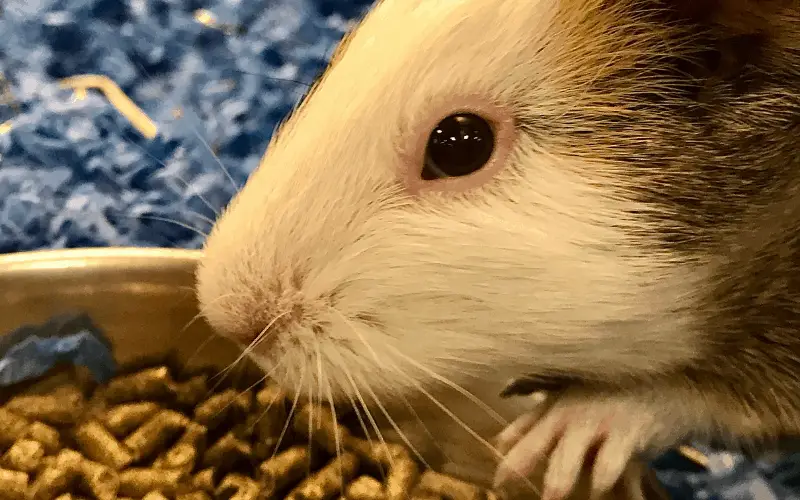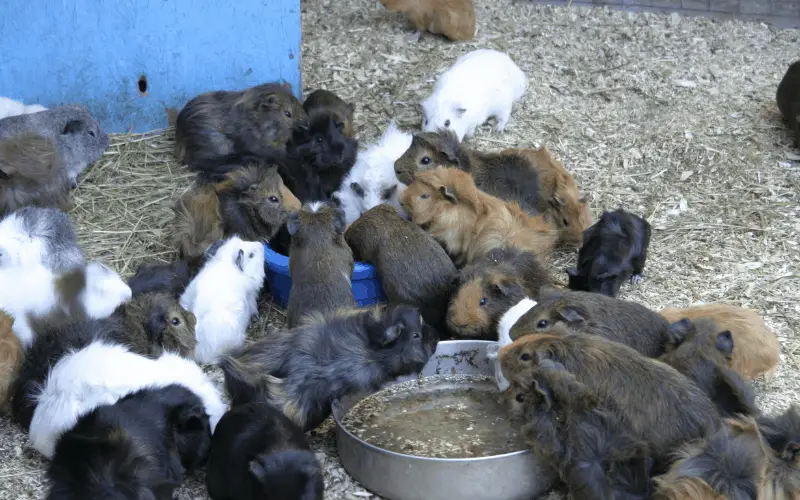Do guinea pigs need pellets? This is one of the numerous questions we often get from guinea pig owners and the simple answer is. Yes, guinea pigs do need pellets – but they can also do without it.

Do Guinea Pigs Need Pellets?
Guinea pigs can get the essential vitamins and minerals that hay lacks from pellets. Vitamin C is important for guinea pigs because they cannot manufacture this vitamin, and they need it daily.
Apart from feeding your guinea pigs with pellets, we also recommend giving them Tangerine Dream Vitamin C treats, just to be sure about the vitamin C. Guinea pigs need hay and fresh foods like spring mix and romaine lettuce.
Most of the pellets are considered to be alfalfa or timothy hay-based and mixed with various ingredients and supplements.
Alfalfa is only recommended for pregnant guinea pigs or young ones (under 12 months) because it’s high in calcium and may cause bladder stones in adults. Guinea pigs that are above 12 months should be fed with Timothy pellets.
Read Also: Why Will Guinea Pig Bite Its Owner?
Guinea Pigs and Pellet

As stated earlier, guinea pigs don’t need pellets; in other words, pellets consumption is not essential for guinea pigs because some kind of pellets absorb water in the stomach and cause swelling.
Thereby obstructing liquids from reaching the bladder and kidneys and therefore opening the door to complications. These kinds of pellets should only be fed in small amounts with a syringe.
Compared to hay and grass, pellets aren’t fibrous enough to keep guinea pigs’ teeth trimmed. Guinea pig doesn’t eat all the fibrous plants and vitamins they need because they satiate so much.
Any guinea pig that consumes such an amount should be weighed weekly to make sure that it’s maintaining a healthy weight.
For all the reasons listed above, pellets are only needed as an additive to an already fatty diet, pellet is not as crucial as other hygienic foods made available to guinea pigs.
Watch this video: Do Guinea Pigs Need Pellets?
What are Different Types of Pellets?
Grain pellets (wheat and rye): They are very dense and slow down digestion.
Gluten-free pellets (quinoa, millet, buckwheat): they are better for digestion but not expected.
Heat-pressed pellets: This kind of pellet lose their vitamins, so manufacturers of pellets add them artificially, most times adding too many that they become harmful rather than beneficial.
Cold-pressed pellets: This type of pellet retain their vitamins and fibers because they’re not subjected to high temperatures.
Fresh/natural pellets: They are healthier and are made of grasses, plants, and herbs. They are made up of high calcium and water content, and any excess is removed in urination.
4 Healthy Diets For Guinea Pigs

Since pellet is not a vital food for guinea pigs and guinea pigs can do without it, we will be listing some other healthy foods that you can feed your guinea pig in the right proportion.
A guinea pig’s diet should contain high-quality grass hay (orchard grass, timothy hay, oat), a limited amount of pellets because guinea pigs can do without pellets and some fresh vegetables.
A guinea pig needs at least 110 – 220g (1/2 – 1 cup) of leafy greens rich with vitamin C per day, as it cannot synthesis the vitamin and will die of deprivation.
Pregnant guinea pigs and babies below six months of age should have an unlimited supply of alfalfa as it’s high in calcium and proteins, which they need to grow or lactate.
Guinea pigs should not be given dried fruits, nuts, grains, seeds, cereals, or sugars. Diets that are high carb may cause gastrointestinal problems and obesity.
Guinea pigs live on routine and habit to feel good. Try not to make any sudden changes in food, feeding times, or containers; otherwise, the piggy might get stressed and refuse to eat. Any changes should be made gradually.
Water can with something like sipper tubes are more preferred than bowls for guinea pigs because they can’t be tipped over or soiled. Still, the guinea pigs want to chew on the end of the tube or clog it by spitting food into it.
Therefore, water bottles have to be made clean and refilled every day. It’s not advised to add any extra vitamins because many guinea pigs don’t like the taste and may drink less.
1. Vitamin C
Importantly, guinea pigs need vegetables rich in vitamin C in addition to pellets. Otherwise, they may develop scurvy.
Even though that pellets are usually made with vitamin C, it degrades quickly – pellets should be fed up to 90 days after the production date. Besides that, not all vegetables and vitamin supplements are sufficient.
Scurvy is an ailment caused by a deficiency in vitamin C, which is attributed to blood problems and an inability to create collagen; the illness can be lethal.
Collagen is vital in their body because it is needed to maintain blood vessels, bone formation, and wound healing. Deficiency in vitamin C has several effects on the guinea pig, such as:
- Fragile blood vessels – translates to fragile tissues, especially in the gums, mouth, skin, muscles, and organ surfaces. Some of the indications are bruising or bleeding of the skin or gums and a decreased appetite since teeth get loose in their sockets.
- Wrong bone and cartilage formation – especially around leg and rib joints. Symptoms are swelling, lameness, stiffness, and joint pain.
- Diarrhea results in weight loss; rough hair coat; no sexual stimulus, weak and lethargic piggy.
- The first primary step in treating scurvy is to change the guinea pig’s diet (with professional guidance). Some not severe cases of the illness can be treated at home. In some instances, piggies require hospitalization.
It is advised that guinea pigs receive vitamin C injections, fluid therapy, pain medication, and nutritional support.
In other to avoid unwanted bruising or injuries, reduce physical activity for at least the first week of treatment. Gradually allow activities as the piggy’s health improves.
Read Also: Can Guinea Pigs Overheat?
2. Hay and Grass
A regular supply of clean and fresh Alfalfa or Timothy hay is an essential component of a healthy guinea pig’s diet. The guinea pig chews on it regularly, as it’s incredibly beneficial:
- Hay helps break down food in the digestive system – protecting the piggy from diarrhea.
- Hay also serves as a trimmer in keeping their teeth trimmed – guinea pig teeth grow continuously, and without something rigid, like hay, to chew on, their teeth will get too big for their mouths. Hard vegetables are an excellent alternative when trimming.
- Finally, guinea pigs like using hay as a form of bedding – then chew on their mattress at night.
It’s recommended to use a large hayrack rather than spreading hay on the floor of the cage. Guinea pigs often make a nasty of themselves and spill water on the ground, making the hay soggy and dirty.
A well-cared-for, seasonal guinea pig food is fresh grass, rich in vitamin C and nutrients in the spring and summer, but not so much during the rest of the year.
A guinea pig should either run around in a garden or have grass pulled out by hand – every day.
After maybe like an hour or two, any of it should be thrown away. Whoever provides food and makes the piggy to feed should double-check that the grass hasn’t been sprayed with herbicides.
3. Fruits and Vegetables
For guinea pigs to get enough vitamins and minerals, domestic guinea pigs should be fed easy-to-digest fruits and vegetables in strict quantities. Generally, Guinea pig doesn’t enjoy change, but they do like to have a varied diet.
Guinea pigs should eat at least three to five different types of vegetables a day. Fruits have high sugar content, so they should be given only once or twice a week to avoid fattening the piggy. So many people are of the opinion that a portion should be about the size of a matchbox.
Before serving a guinea pig, wash fruits and vegetables carefully and thoroughly, dry them, and remove any seeds or pips. Lastly, slice them up into sizeable chunks to avoid choking the piggy.
4. Treats
When it is concerned with guinea pigs, treats are foods that they enjoy eating. Guinea pigs are not always hungry for sugary (or any kind) treats like humans do.
Truthfully, they don’t even enjoy chocolate and cake that much and will probably get sick and fat if they eat them.
Apart from fruits, guinea pigs enjoy the occasional fruit tree twig. At least once in a while, an owner can even give his/her guinea pig a vitamin C tablet as a treat – but only rarely.
Guinea pigs should not be allowed to consume human food, especially not meat (because they’re herbivores) or potatoes. They can’t digest pastries, dairy, chocolate, or anything deriving from an animal.
Nuts, seeds, cereals, and crackers aren’t generally accepted as they can harm the guinea pig’s mouth or cause stomach problems.
Things like ‘treat sticks’ for guinea pigs shouldn’t be bought either, as they consist mostly of nuts and seeds.
The truth is that most store-bought treats are entirely unnecessary and even harmful. Any treats that should be given to guinea pigs should be natural, healthy, enjoyable, and occasional.
New grass that is free from herbicide is an excellent meal for the spring and summer. It’s vital to make sure that a guinea pig gets all the vitamin C needed per day.
Scurvy is a vitamin C deficiency disease, and it extraordinarily unpleasant and possibly lethal.
The occasional fruit is a great treat. Although guinea pigs enjoy them, treats are not an essential part of their diet. As long as the guinea pig is fed very well and is happy and healthy, owners have nothing to worry about.
Read Also: Can Guinea Pigs Be Alone For One Week?
Conclusion
In summary, pellets are not as necessary as most manufacturers make them out to be. There’s no black-and-white answer as to whether guinea pigs need pellets or can go without pellets.
Because they genuinely don’t need pellets to survive as they can live on the rest of their diet and their general health. Guinea pigs are bound to consume grass hay (alfalfa or timothy) and vegetables daily to survive.